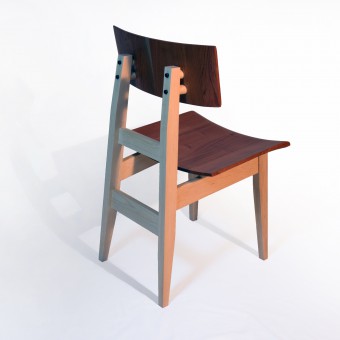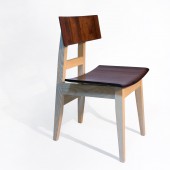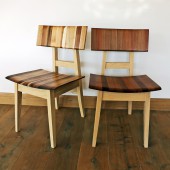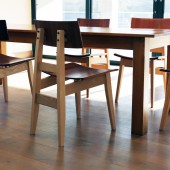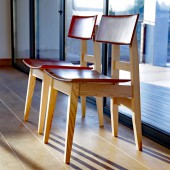DESIGN NAME:
Zene
PRIMARY FUNCTION:
Dining chair
INSPIRATION:
The beauty grain and colour of indigenous African timber was a key aesthetic inspiration for this project. The more technical inspiration for the overall work, including the frame design came from iconic designers such as Hans J Wegner (for example the CH20 Elbow Chair). The coopering technique was inspired by Ontario furniture designer Adrian Ferrazzutti.
UNIQUE PROPERTIES / PROJECT DESCRIPTION:
This series of dining chairs have American ash frames and showcase different hardwood timbers for the seat/backrest combinations.
The chairs draw on the ancient art of 'coopering'; or how oak barrels are made for fermentation purposes. The curved forms of the seat/backrest are not formed by bending but rather by joining and shaping solid hardwood timber.
The chair strives to be very strong and beautiful. In short: Zene -
elegant, comfortable and dependable.
OPERATION / FLOW / INTERACTION:
Zene is designed mainly for use at the dining table and is designed for extended dining comfort.
PROJECT DURATION AND LOCATION:
The first prototype was conceived in Johannesburg in 2007. It was slowly refined as background task over 10 years, and the first set of 6 chairs was produced in 2017
FITS BEST INTO CATEGORY:
Furniture Design
|
PRODUCTION / REALIZATION TECHNOLOGY:
The Zene design evolved over a number of years. The starting point was probably a fascination with the art of coopering and how this has been applied to furniture design. Building the segmented seat and backrests took some practice to perfect, as did the development of custom modifications to standard workshop tools to shape and finish the smoothly shaped forms.
SPECIFICATIONS / TECHNICAL PROPERTIES:
515mm wide x 570mm deep x 890mm high
seat: 515mm wide x 390mm deep
back:515mm wide x 200mm high
TAGS:
zene, dining chair, south africa, hardwood, curved, cooper, danish modern, minimalist
RESEARCH ABSTRACT:
Danish modern designs were studied and absorbed to consider different ways of rendering the frame, and its relationship to the seat, and to think through the spatial relationship of the seat to the backrest.
Web search was used to think about typical dimensions for the seat but in the end prototyping proved most fun.
CHALLENGE:
Building the coopered seat/backrests was challenging as it required careful attention to the compression forces on the material and how best to achieve high compression without causing the seats to 'implode'.
Shaping the rough seats into finely finished and smooth curves required considerable re-working of the custom tooling to achieve the desired results
ADDED DATE:
2017-06-24 18:23:51
TEAM MEMBERS (1) :
John G Williams: designer, craftsman
IMAGE CREDITS:
all images by the designer: John G Williams
PATENTS/COPYRIGHTS:
no patents pending
|



